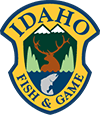Gray Partridge
HABITAT
Grassland in gently rolling terrain, and near a water source.
TASTE
Dark, lean meat with a rich flavor. Excellent table fare.
ABUNDANCE
Moderate populations in certain Idaho regions (Southwestern, Central & Northern Idaho).
LICENSE, TAGS AND PERMITS NEEDED
Valid Idaho hunting license.
SPECIES INFORMATION
The gray partridge is a medium sized partridge introduced to various places in North America from Europe. They are sometimes referred to as Hungarian partridge or “Huns.” They originally dispersed into Idaho from neighboring states of Oregon and Washington during the early 1900s. Gray partridge introduction efforts were initiated in Idaho during 1921 and resulted in establishment of populations across much of the state.
Gray partridges generally are associated with fertile soils and natural grasslands of flat or gently rolling terrain. A combination of cereal grains and herbaceous cover in hayfields, grasses, weedy vegetation, and extensive shelterbelts provides preferred habitat. However, availability of permanent nesting cover likely is a limiting factor in extensively cultivated landscapes. On the Palouse Prairie in Idaho, permanent cover (e.g., fencerows, farmsteads, roadside and railroad rights-of-way, waterways, idle grass, brush and timber, pasture, and hay) was preferred during late spring, summer, and autumn. During winter, plowed stubble was preferred and winter wheat generally was avoided.
In southern Idaho, gray partridge are also found in sagebrush-grass dominated areas, not associated with cultivated land. However, no data on habitat preferences are available for gray partridge that inhabit canyon grasslands and mountainous areas in the Great Basin and Intermountain West where they often overlap with chukar populations.
Gray partridge are opportunistic feeders and their diet is comprised mostly of plant materials, which includes seeds of domestic crops and weeds in crop fields. Diets vary seasonally and are comprised mostly of insects in summer, seeds of wild plants in autumn, seeds of crop plants in winter, and green leafy vegetation during spring.
Water needs of gray partridge remain relatively unknown in the western U. S. Whereas Yeatter believed gray partridge met their water requirement by utilizing dew and succulent foods in the Great Lakes region, Porter reported gray partridge in western Utah required free water in dry desert areas.
Gray partridge are monogamous and pairs are most often formed between coveys; however, intra-covey pairing occurs among previously paired adults. Dates of breeding-pair formation vary considerably with region and weather conditions. In Idaho, pairs appear during mid-January.
Predation is an important source of gray partridge mortality; typically greatest during nesting, brood-rearing, and winter. Gray partridge are vulnerable to both avian and mammalian predators.

